Page 390 of 419

Scheduled Maintenance
7-12
52,500 Miles (87 500 km)
�Check rear/front axle fluid level and add fluid as needed. Check constant
velocity joints and axle seals for leaking.
�Rotate tires. See ªTire Inspection and Rotationº in the Index for proper
rotation pattern and additional information. (See footnote +.)
60,000 Miles (100 000 km)
�If Equipped: Replace passenger compartment air filter. If you drive regularly
under dusty conditions, the filter may require replacement more often.
�Check rear/front axle fluid level and add fluid as needed. Check constant
velocity joints and axle seals for leaking.
�Rotate tires. See ªTire Inspection and Rotationº in the Index for proper
rotation pattern and additional information. (See footnote +.)
�Inspect engine accessory drive belt.
An Emission Control Service.
�Replace fuel filter.
An Emission Control Service. (See footnote�.)
�Inspect Exhaust Gas Recirculation (EGR) system as described in the
service manual.
An Emission Control Service.(See footnote �.)
ACTUAL
SERVICED BY:MILEAGE
DATE
ACTUAL
SERVICED BY:MILEAGE
DATE
Page 391 of 419
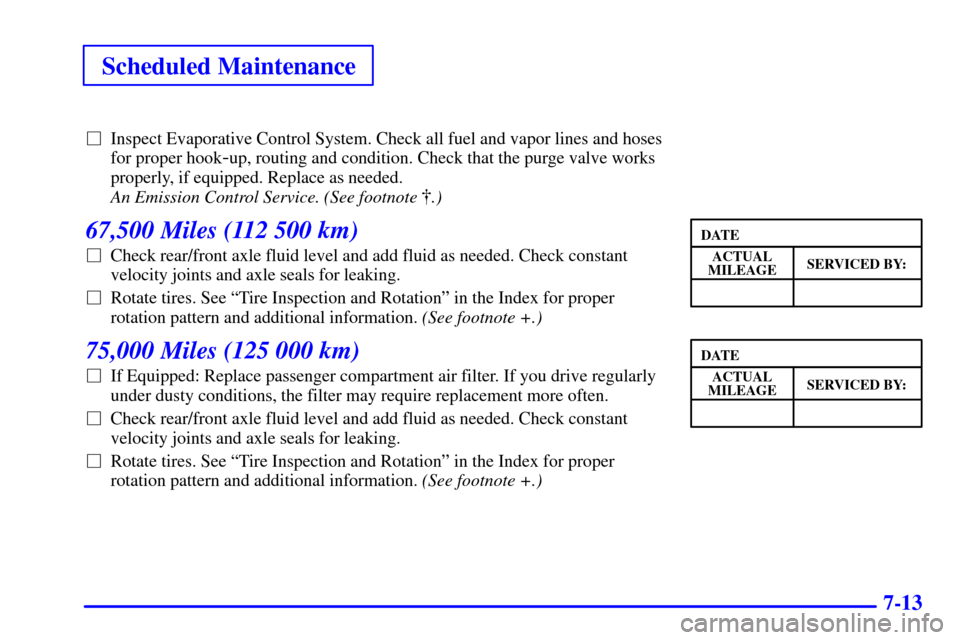
Scheduled Maintenance
7-13
�Inspect Evaporative Control System. Check all fuel and vapor lines and hoses
for proper hook
-up, routing and condition. Check that the purge valve works
properly, if equipped. Replace as needed.
An Emission Control Service. (See footnote �.)
67,500 Miles (112 500 km)
�Check rear/front axle fluid level and add fluid as needed. Check constant
velocity joints and axle seals for leaking.
�Rotate tires. See ªTire Inspection and Rotationº in the Index for proper
rotation pattern and additional information. (See footnote +.)
75,000 Miles (125 000 km)
�If Equipped: Replace passenger compartment air filter. If you drive regularly
under dusty conditions, the filter may require replacement more often.
�Check rear/front axle fluid level and add fluid as needed. Check constant
velocity joints and axle seals for leaking.
�Rotate tires. See ªTire Inspection and Rotationº in the Index for proper
rotation pattern and additional information. (See footnote +.)
ACTUAL
SERVICED BY:MILEAGE
DATE
ACTUAL
SERVICED BY:MILEAGE
DATE
Page 392 of 419
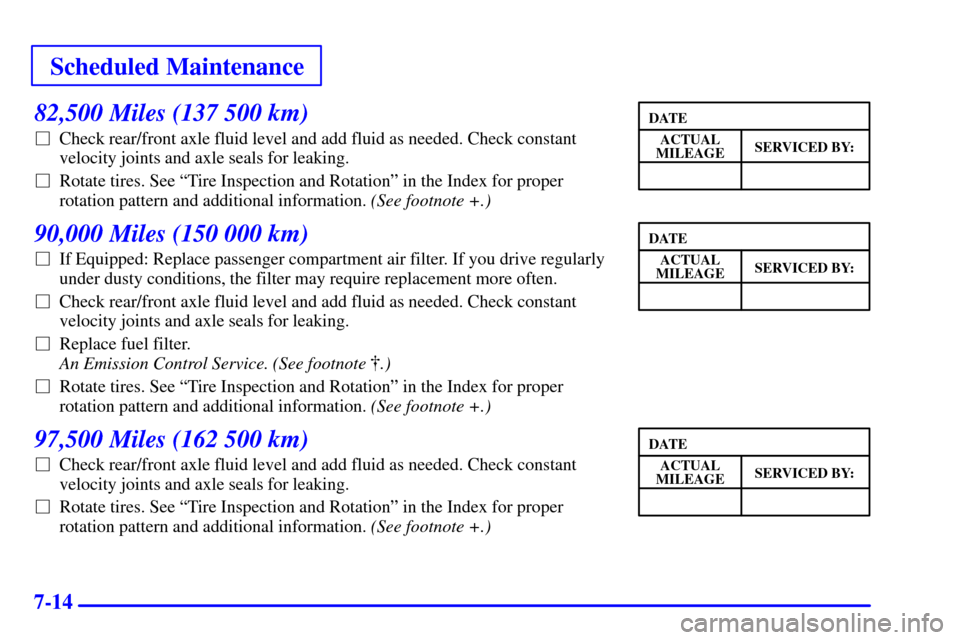
Scheduled Maintenance
7-14
82,500 Miles (137 500 km)
�Check rear/front axle fluid level and add fluid as needed. Check constant
velocity joints and axle seals for leaking.
�Rotate tires. See ªTire Inspection and Rotationº in the Index for proper
rotation pattern and additional information. (See footnote +.)
90,000 Miles (150 000 km)
�If Equipped: Replace passenger compartment air filter. If you drive regularly
under dusty conditions, the filter may require replacement more often.
�Check rear/front axle fluid level and add fluid as needed. Check constant
velocity joints and axle seals for leaking.
�Replace fuel filter.
An Emission Control Service. (See footnote �.)
�Rotate tires. See ªTire Inspection and Rotationº in the Index for proper
rotation pattern and additional information. (See footnote +.)
97,500 Miles (162 500 km)
�Check rear/front axle fluid level and add fluid as needed. Check constant
velocity joints and axle seals for leaking.
�Rotate tires. See ªTire Inspection and Rotationº in the Index for proper
rotation pattern and additional information. (See footnote +.)
ACTUAL
SERVICED BY:MILEAGE
DATE
ACTUAL
SERVICED BY:MILEAGE
DATE
ACTUAL
SERVICED BY:MILEAGE
DATE
Page 395 of 419
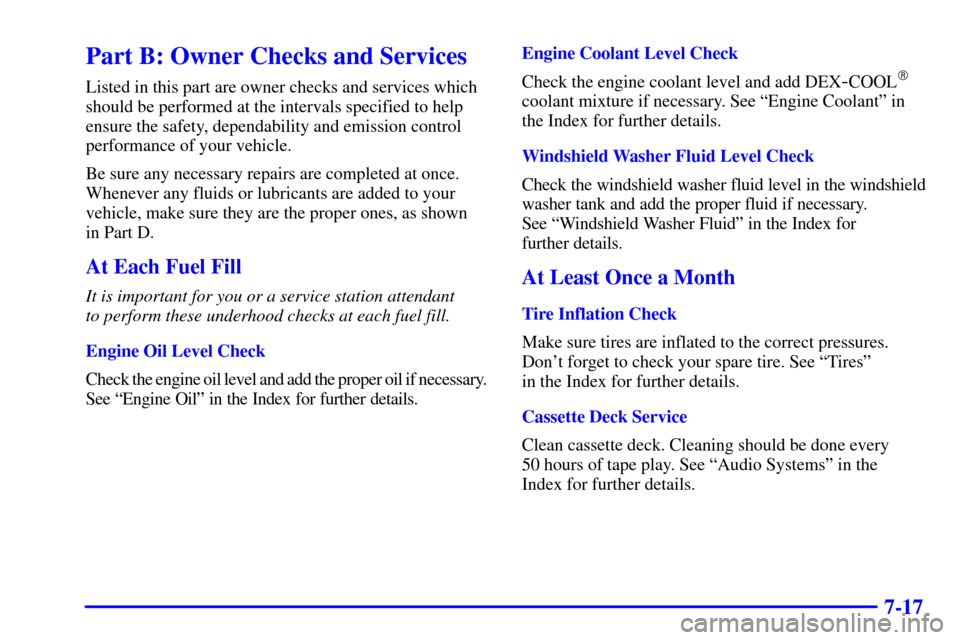
7-17
Part B: Owner Checks and Services
Listed in this part are owner checks and services which
should be performed at the intervals specified to help
ensure the safety, dependability and emission control
performance of your vehicle.
Be sure any necessary repairs are completed at once.
Whenever any fluids or lubricants are added to your
vehicle, make sure they are the proper ones, as shown
in Part D.
At Each Fuel Fill
It is important for you or a service station attendant
to perform these underhood checks at each fuel fill.
Engine Oil Level Check
Check the engine oil level and add the proper oil if necessary.
See ªEngine Oilº in the Index for further details.Engine Coolant Level Check
Check the engine coolant level and add DEX
-COOL�
coolant mixture if necessary. See ªEngine Coolantº in
the Index for further details.
Windshield Washer Fluid Level Check
Check the windshield washer fluid level in the windshield
washer tank and add the proper fluid if necessary.
See ªWindshield Washer Fluidº in the Index for
further details.
At Least Once a Month
Tire Inflation Check
Make sure tires are inflated to the correct pressures.
Don't forget to check your spare tire. See ªTiresº
in the Index for further details.
Cassette Deck Service
Clean cassette deck. Cleaning should be done every
50 hours of tape play. See ªAudio Systemsº in the
Index for further details.
Page 397 of 419
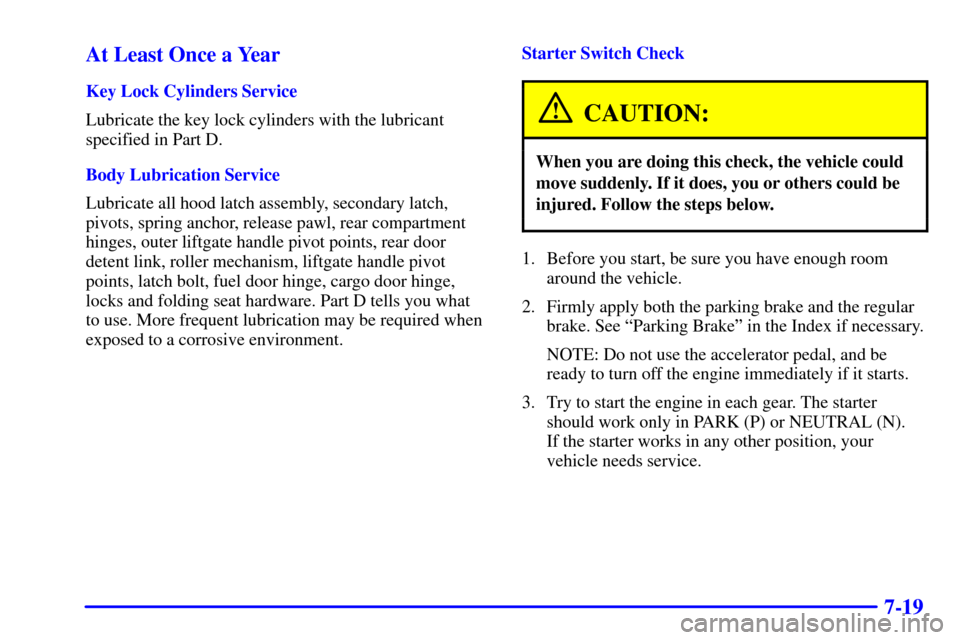
7-19 At Least Once a Year
Key Lock Cylinders Service
Lubricate the key lock cylinders with the lubricant
specified in Part D.
Body Lubrication Service
Lubricate all hood latch assembly, secondary latch,
pivots, spring anchor, release pawl, rear compartment
hinges, outer liftgate handle pivot points, rear door
detent link, roller mechanism, liftgate handle pivot
points, latch bolt, fuel door hinge, cargo door hinge,
locks and folding seat hardware. Part D tells you what
to use. More frequent lubrication may be required when
exposed to a corrosive environment.Starter Switch Check
CAUTION:
When you are doing this check, the vehicle could
move suddenly. If it does, you or others could be
injured. Follow the steps below.
1. Before you start, be sure you have enough room
around the vehicle.
2. Firmly apply both the parking brake and the regular
brake. See ªParking Brakeº in the Index if necessary.
NOTE: Do not use the accelerator pedal, and be
ready to turn off the engine immediately if it starts.
3. Try to start the engine in each gear. The starter
should work only in PARK (P) or NEUTRAL (N).
If the starter works in any other position, your
vehicle needs service.
Page 404 of 419
7-26
USAGEFLUID/LUBRICANT
Hood HingesMulti-Purpose Lubricant,
Superlube� (GM Part
No. 12346241 or equivalent).
Body Door
Hinge Pins,
Liftgate Hinge
and Linkage,
Folding Seats
and Fuel
Door HingeMulti-Purpose Lubricant,
Superlube� (GM Part
No. 12346241 or equivalent).
USAGEFLUID/LUBRICANT
Outer Tailgate
Handle
Pivot PointsMulti-Purpose Lubricant,
Superlube� (GM Part
No. 12346241 or equivalent).
Weatherstrip
ConditioningDielectric Silicone Grease (GM
Part No. 12345579 or equivalent).
Weatherstrip
SqueaksSynthetic Grease with Teflon,
Superlube� (GM Part
No. 12371287 or equivalent).
Page 412 of 419
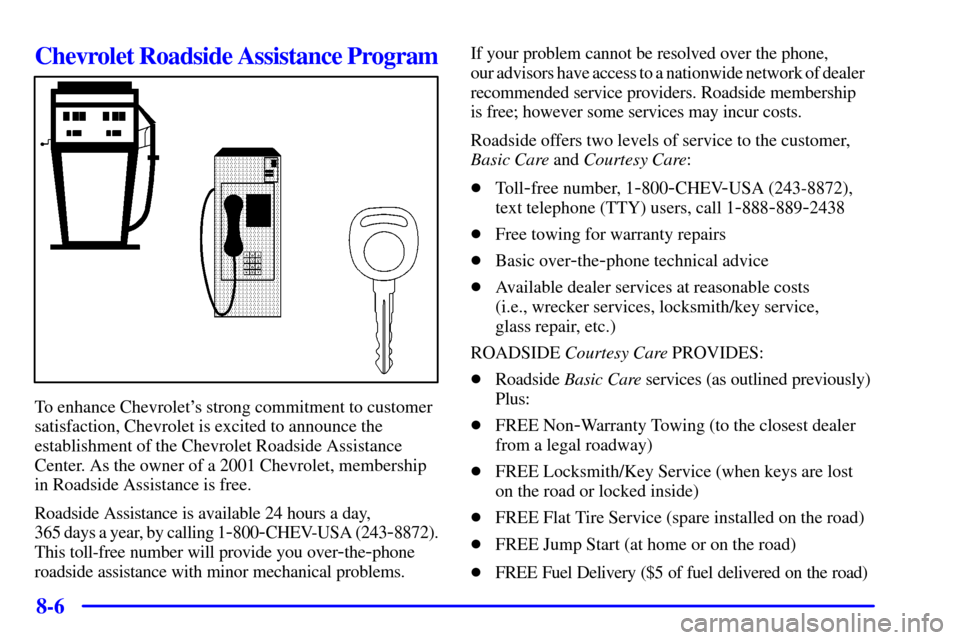
8-6
Chevrolet Roadside Assistance Program
To enhance Chevrolet's strong commitment to customer
satisfaction, Chevrolet is excited to announce the
establishment of the Chevrolet Roadside Assistance
Center. As the owner of a 2001 Chevrolet, membership
in Roadside Assistance is free.
Roadside Assistance is available 24 hours a day,
365 days a year, by calling 1
-800-CHEV-USA (243-8872).
This toll-free number will provide you over
-the-phone
roadside assistance with minor mechanical problems. If your problem cannot be resolved over the phone,
our advisors have access to a nationwide network of dealer
recommended service providers. Roadside membership
is free; however some services may incur costs.
Roadside offers two levels of service to the customer,
Basic Care and Courtesy Care:
�Toll
-free number, 1-800-CHEV-USA (243-8872),
text telephone (TTY) users, call 1
-888-889-2438
�Free towing for warranty repairs
�Basic over
-the-phone technical advice
�Available dealer services at reasonable costs
(i.e., wrecker services, locksmith/key service,
glass repair, etc.)
ROADSIDE Courtesy Care PROVIDES:
�Roadside Basic Care services (as outlined previously)
Plus:
�FREE Non
-Warranty Towing (to the closest dealer
from a legal roadway)
�FREE Locksmith/Key Service (when keys are lost
on the road or locked inside)
�FREE Flat Tire Service (spare installed on the road)
�FREE Jump Start (at home or on the road)
�FREE Fuel Delivery ($5 of fuel delivered on the road)
Page 414 of 419
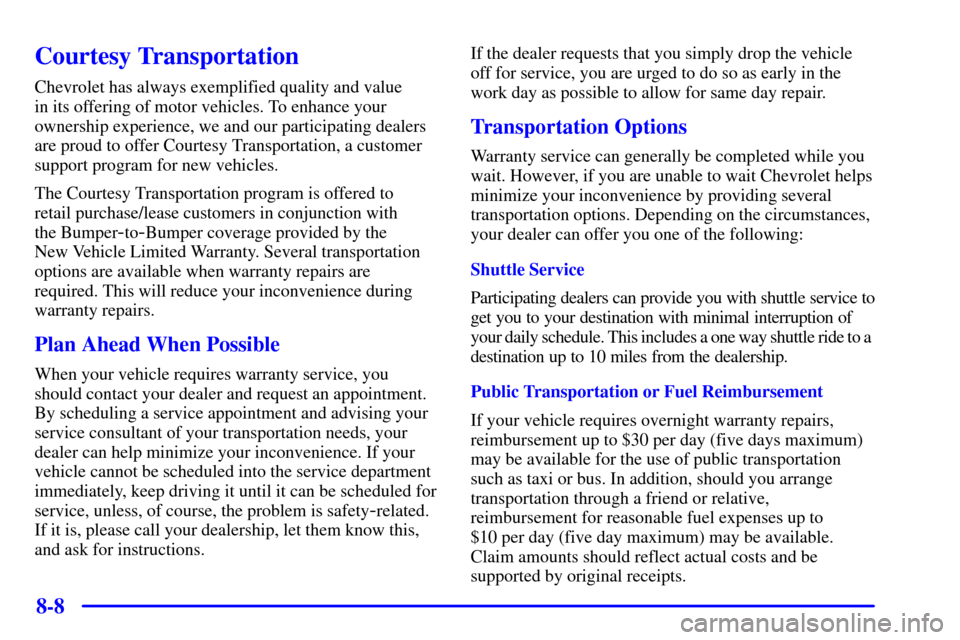
8-8
Courtesy Transportation
Chevrolet has always exemplified quality and value
in its offering of motor vehicles. To enhance your
ownership experience, we and our participating dealers
are proud to offer Courtesy Transportation, a customer
support program for new vehicles.
The Courtesy Transportation program is offered to
retail purchase/lease customers in conjunction with
the Bumper
-to-Bumper coverage provided by the
New Vehicle Limited Warranty. Several transportation
options are available when warranty repairs are
required. This will reduce your inconvenience during
warranty repairs.
Plan Ahead When Possible
When your vehicle requires warranty service, you
should contact your dealer and request an appointment.
By scheduling a service appointment and advising your
service consultant of your transportation needs, your
dealer can help minimize your inconvenience. If your
vehicle cannot be scheduled into the service department
immediately, keep driving it until it can be scheduled for
service, unless, of course, the problem is safety
-related.
If it is, please call your dealership, let them know this,
and ask for instructions.If the dealer requests that you simply drop the vehicle
off for service, you are urged to do so as early in the
work day as possible to allow for same day repair.
Transportation Options
Warranty service can generally be completed while you
wait. However, if you are unable to wait Chevrolet helps
minimize your inconvenience by providing several
transportation options. Depending on the circumstances,
your dealer can offer you one of the following:
Shuttle Service
Participating dealers can provide you with shuttle service to
get you to your destination with minimal interruption of
your daily schedule. This includes a one way shuttle ride to a
destination up to 10 miles from the dealership.
Public Transportation or Fuel Reimbursement
If your vehicle requires overnight warranty repairs,
reimbursement up to $30 per day (five days maximum)
may be available for the use of public transportation
such as taxi or bus. In addition, should you arrange
transportation through a friend or relative,
reimbursement for reasonable fuel expenses up to
$10 per day (five day maximum) may be available.
Claim amounts should reflect actual costs and be
supported by original receipts.